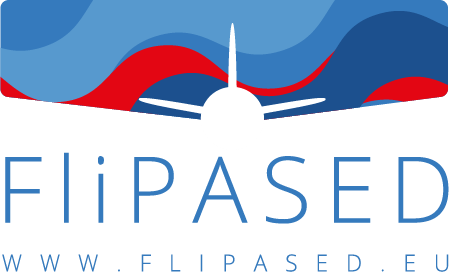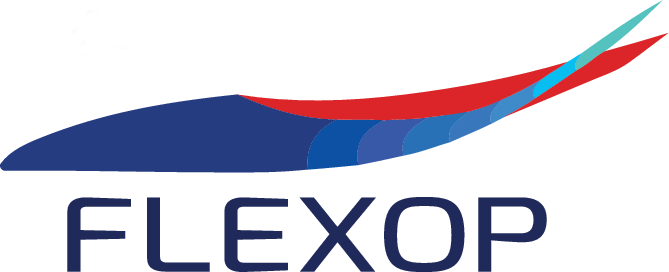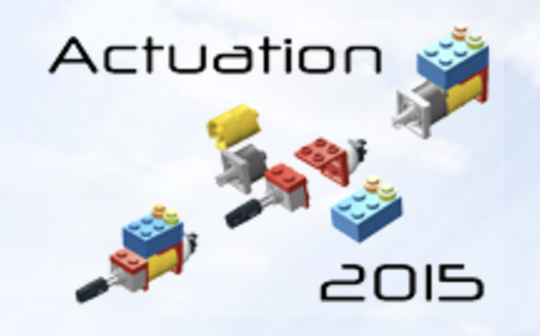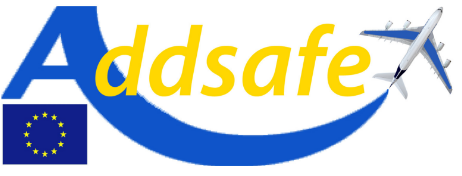

 Flight Phase Adaptive Aero-Servo-Elastic Aircraft Design Methods (FliPASED) opens a completely new dimension for the integrated aircraft design.
Coupling between aeroelasticity, gust response, flight control methods, instrumentation and certification aspects is not exploited in current aircraft design.
A common set of models, coupled with joint requirements enable a multidisciplinary-optimized design for the entire aircraft, leading to more optimized overall performance.
Flight Phase Adaptive Aero-Servo-Elastic Aircraft Design Methods (FliPASED) opens a completely new dimension for the integrated aircraft design.
Coupling between aeroelasticity, gust response, flight control methods, instrumentation and certification aspects is not exploited in current aircraft design.
A common set of models, coupled with joint requirements enable a multidisciplinary-optimized design for the entire aircraft, leading to more optimized overall performance.
The concept of exploiting coupling between disciplines will take advantage of tools developed by the partners in former projects. The main objectives of the proposal aim at tightly coupled multi-objective optimization of advanced, active controlled wing designs through the integration of a collaborative design tool chain. More than 10% fuel efficiency improvement, and 20% reduction in peak amplitude of the gust response, as well as a 50% reduction of number of distinct models used during the development and certification process are set as project goals. Through the integration of all discipline tools from aerodynamics, structural design, aeroelastic simulation and control design in one integrated tool chain an active, condition optimized wing design becomes feasible, enabling enhanced performance at lower weight and cost.
The project will raise the efficiency of a currently separately existing development toolchains, by advanced multidisciplinary and collaborative capabilities for whole aircraft along its life cycle. It will develop methods and tools for very accurate flexible-mode modelling and flexible aircraft control synthesis, in the context of reliable implementation of the avionics system, taking into consideration the fault detection and reconfiguration. The accuracy of developed tools and methods will be validated on a safe and affordable experimental platform, and results will be shared along with design requirements and standardized interfaces in an open source approach.
This research covers the geotagged image-based localization of aerial vehicles.
Our partner in this research is the Machine Perception Research Laboratory
The original (*.tif) images were provided by Baukoord-Europe Ltd. Any commercial use is only possible with the written consent of Baukoord-Europe Ltd.
 The FLEXOP project is about developing multidisciplinary aircraft design capabilities for Europe that will increase
competitiveness with emerging markets, particularly in terms of aircraft development costs.
A closer coupling of wing
aeroelasticity and flight control systems in the design process opens new opportunities to explore previously unviable
designs. Common methods and tools across the disciplines also provide a way to rapidly adapt existing designs into
derivative aircraft, at a reduced technological risk (e.g. using control to solve a flutter problem discovered during
development). The goal will be achieved by:
The FLEXOP project is about developing multidisciplinary aircraft design capabilities for Europe that will increase
competitiveness with emerging markets, particularly in terms of aircraft development costs.
A closer coupling of wing
aeroelasticity and flight control systems in the design process opens new opportunities to explore previously unviable
designs. Common methods and tools across the disciplines also provide a way to rapidly adapt existing designs into
derivative aircraft, at a reduced technological risk (e.g. using control to solve a flutter problem discovered during
development). The goal will be achieved by:
These inter-disciplinary capabilities will improve the design cycle and the Verification & Validation process of both derivative and new aircraft. Better control of development and certification costs can be achieved if these capabilities are used to address problems early in the design process. Flight test data will be posted on the project website to provide a benchmark for the EU aerospace community. The project’s results will serve as a preliminary outlining of certification standards for future EU flexible transport aircraft.
Sense and avoid (S&A) capability is a crucial ability for the future unmanned aerial vehicles (UAVs). It is vital to integrate civilian and governmental UAVs into the common airspace. In a S&A scenario the own UAV is the observer which should estimate the probability (or possibility) of collision and initiate an avoidance maneuver if required. The probability of collision can be estimated through the estimation of direction and distance of the close other aircraft or UAV called intruder. Monocular vision based solutions can be cost and weight effective therefore especially good for small UAVs. However, their application needs persistent excitation of the filter which estimates the intruder distance and flying direction because of the inherent scale ambiguity of the monocular image. This means continuous maneuvering of the own craft which is time and energy consuming. That’s why our current research targets the development of other methods to decide about the possibility of collision considering solely image parameters without any special excitation of the system.
The Sindy Project is MTA SZTAKI's own unmanned aerial vehicle development project. The aircraft was designed with the aim to serve as a test platform for UAV on-board avionics system development. The mathematical model is soon to be identified, and is going to be made available. The main goal was to create an easily reproducible aircraft, using accessible parts and simple technologies, which only require ordinary tools. This feature and the available mathematical model combined, make this aircraft a good platform for control research purposes. Since the integration of UAVs to common airspace requires safe aircraft, considerable effort is put in developing safety critical UAVs. The twin boom configuration of the airframe offers duplicated control surfaces, even the elevator is split. This, in addition to the two electric motors enables this plane to serve as a test platform for various research purposes like reconfiguring control developments, sense and avoid collision avoidance sys- tem and many others. The fuselage is entirely reserved for the payload; it can carry up to 1-4 kgs of avionics and test equipment. It has a modular construction: different set-ups can be installed to the frontal section in a few minutes, and the fuselage itself is also easily changeable. The fact that easy reproduction was given priority over weight reduction significantly constrained the possible shapes and the quality of the parts used. As a result of our efforts to reach high standards for the aircraft, good general condition and functionality can be maintained, even after numerous disassembles. The foam and plywood parts made the easy modification possible, and the smooth and shiny surfaces give an aesthetic look to the aircraft. The vast majority of the components are either laser cut plywood or hot-wire cut foam. Such technologies provide the cheap and fast manufacturing of the components. Coverings of the nacelles and the fuselage are thermoformed in vacuum. The use of precut parts enables a fast assembly: a new aircraft can be built in about 180 man-hours. For three people, the assembly spans through 5 days, taking the curing times into account.
 Currently, commercial aircraft fault tolerant control (FTC) strategies in the flight control system (FCS) are based on fail-safe approaches whereby a nominal ("normal") control law is switched first to a robust ("alternate") solution and then if necessary to a "direct" law. Note that despite its name, the later law ensures a minimal level of stability augmentation independently of the type of abnormal event. The advantages of the current approach are the ease of design, analysis and certification.
Currently, commercial aircraft fault tolerant control (FTC) strategies in the flight control system (FCS) are based on fail-safe approaches whereby a nominal ("normal") control law is switched first to a robust ("alternate") solution and then if necessary to a "direct" law. Note that despite its name, the later law ensures a minimal level of stability augmentation independently of the type of abnormal event. The advantages of the current approach are the ease of design, analysis and certification.
Each control law is designed off-line for different levels of robustness and each includes a set of specific guidance and control (G&C) functions which assist the pilot during the flight. Some of these functions are switched off as the control law is switched from "normal" to "direct" and even though this state-of-practice is safe, it is also known to decrease the easiness of the piloting task and as functions get de-activated the use of automatic guidance (Auto-Pilot) or navigation systems (Flight Management) is prevented.
More advanced and less conservative FTC-FCS approaches have not been used due to mainly:
The previous standard FTC-FCS approach was programmatically pursued since aircraft makers seek above all safety and acceptable performance (Robust Stability). But for the future aircraft, it has been identified the need to change the design paradigm towards a performance-oriented one:
"Full-time & all-event availability of performance-optimized G&C functions"
This paradigm can be translated into the desire to extend the operability of the G&C functions designed to assist the pilot in keeping the flight safe and making the flight task easier and the mission optimal.
The main goal of RECONFIGURE is to investigate and develop aircraft guidance and control (G&C) technologies that facilitate the automated handling of off-nominal/abnormal events and optimize the aircraft status and flight. The automatism of the G&C will help alleviate the pilots' task and optimize performance by automatically reconfiguring the aircraft to its optimal flight condition. This automatism and optimization must be performed while maintaining the current aircraft safety levels.
 The All-Electric Aircraft is a major target for the next generation of aircraft to lower consumption of non-propulsive power and thus fuel burn.
To eliminate hydraulic circuits, pumps and reservoirs, Electro Mechanical Actuators (EMA) are mandatory but now need to meet cost, reliability and weight requirements from the airframers.
The All-Electric Aircraft is a major target for the next generation of aircraft to lower consumption of non-propulsive power and thus fuel burn.
To eliminate hydraulic circuits, pumps and reservoirs, Electro Mechanical Actuators (EMA) are mandatory but now need to meet cost, reliability and weight requirements from the airframers.
ACTUATION 2015 aims to develop and validate a common set of standardised, modular and scalable EMA resources for all actuators (flight control, high lift, main landing gear, door, thrust reverser) and all types of aircraft (business/regional/commercial airplanes and helicopters).
Compared to the A320, ACTUATION 2015 will reduce the overall Life Cycle Costs of actuators by 30%, improve reliability by 30% and reduce aircraft weight by 500kg. The project relies on recent advances made in EU and national projects to integrate the required technologies (solid state power distribution, power electronics, operation in harsh conditions, jam tolerant EMA) to overcome the current barriers to EMA and mature EMA technologies to TRL 5.
Standardising EMA modules (motors, power drive electronics, mechanics, sensing) will be a key enabler to succeed in achieving cost objectives and developing the supply chain. Standardisation will start during the project with the support of a standardisation body (CEN).
The technical approach will be to gather detailed airframes requirements, specify a set of standard modules and develop prototypes for assessment at component and actuator level through rig tests and the virtual validation of modules. In parallel, a unified EMA design process supported by standard methods and tools will also be developed. ACTUATION 2015 will complement existing projects, notably CLEAN SKY SGO with an EMA solution, and pave the way towards the ACARE 2020 All-Electric Aircraft.
 Subject of the project:
Subject of the project:
Recent airliner accident statistics show that about 16% of the accidents between 1993 and 2007 can be attributed to Loss of Control (LOC), caused by a piloting mistake, technical malfunctions or unusual upsets due to external disturbances. LOC is intrinsically related to the guidance and control (G&C) system of the aircraft, and includes sensors and actuators failures. The state-of-practice for aircraft manufacturers to diagnose these faults and obtain full flight envelope protection is to provide high levels of hardware redundancy in order to perform coherency tests and ensure sufficient available control action. This hardware-redundancy based fault detection and diagnosis (FDD) is becoming increasingly problematic when used in conjunction with the many innovative technical solutions being developed by the aeronautical sector to satisfy the greener and safety imperatives demanded by society. The objective of the project to develop FDD methods based on the analytical redundancy principle providing usable approaches to advanced aerospace industries.
Project objectives:
ADDSAFE tries to overcome the technological gap by facing the following two challenges: i) helping the scientific community to develop the best suited FDD methods capable of handling the real-world challenges raised by industry; and ii) ensuring acceptance and widespread use of these advanced theoretical methods by the aircraft industry. The overall aim of the project is to develop and apply model-based FDD methods for civil aircraft in order to increase aircraft safety and reduce development/maintenance costs. The use of these advanced FDD synthesis and tuning methods in conjunction with reliable software verification & validation (V&V) tools will also reduce the costs for development and certification. Three main benefits that will be achieved in pursuit of ADDSAFE’s aim are: i) Identification and definition of a set of guidelines for aircraft G&C FDD. 2) Improved methods and understanding of aircraft G&C FDD. 3) A step towards a V&V process for FDD systems.